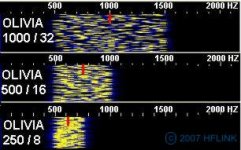Depends on how secure you really want it (and whether it is pre- or post- shtf or wrol...)?
Anything that uses any public or private infrastructure I would not trust without some level of (nonstandard, because anything that is "public" or COTS is not truly secure) encryption on TOP of whatever carrier or data path you are using with your comms equipment.
You have to think outside the box sometimes (most of the time). CW, PSK or other data modes on things like AM or SSB CB radio (Europe is doing that a LOT right now), and then once TSHTF or WROL, roll out the OTP encryption.
Or, use COTS encryption with a filler of random characters here and there so that when the packets are sent, nobody knows for sure where the actual data starts and stops.
Then point is that everybody should be getting these systems and plans in place now (actually YEARS ago), and testing them often to make sure that once the shoe falls off the last foot, that you can still connect to who you need to. Having a pile of unprogrammed "Fengs" in the corner and plans to hit "the local repeater" may not cut it after the power has been out for a few days. Get out there and "Play" with what you have, NOW, while you can make changes or additions. Antenna upgrades, more coax, or even a repeater cable (to go from Feng to Feng in a waterproof box hung up in a tree) may be impossible to get once the stuff hits the air circulator. If you can't communicate NOW when times are (technically) good, don't expect it to all work groovy when the times are in the crapper.
That funny PACE plan comes into demand real quick when the "Spicy" knob is turned to 11. I would suggest anyone that wants comms to have at minimum a good GMRS or FRS/GMRS set of radios for local comms, a CB (SSB would be a major bonus), a good shortwave receiver (SSB capable again) and a Feng, and all the additional parts and pieces to go with them. The shortwave can monitor a almost all of the HF signals, the FENG can monitor most of the common VHF and lower UHF signals. The CB can pick up quite a bunch of local and not so local traffic, and they are everywhere. The FRS/GMRS will do for the local comms. But that could cover most of the Primary, Alternate, Contingency, and Emergency parts of the PACE plan. You will need options.
Don't rely on things that:
- Need Infrastructure to work that you don't own or have any control over.
- Use a communications path or circuit (including internet) that you don't control at all, or can guarantee isn't monitored
- Use anything on a cell tower as anything that connects to them, gets tracked.
- Use anything satellite based (same reason as cellular).
Yes, if you want real options for distance comms, you are going to need to get your amateur license now, practice and learn NOW, and then have the knowledge of things like NVIS and LPI data mode comms for later. Distance comms is either going to need higher power (bad) and lower frequency (good) and require a license, or you are going to have to use COTS equipment like SSB CBs, and digital modes that can keep your signal WELL below the noise floor like Olivia. With the right antenna, and digital modes, you don't need a 100+ watt radio, 10 watts or less will do just fine for hundreds or thousands of miles, you just have to know what bands to use and when to use them and have the receiving stations ready and on frequency at the right time (SCHEDS).
Even if all you have right now is a bubble pack of two FRS/GMRS radios and one CB (and you have a friend with another CB, get out and "play" with all of them to see what is possible during what times of the days, and during what other "variables" (Weather, sun activity, locations...). Log what you find so that you can share notes and work out with ALL of your team what works and what does not (and try multiple times during the day and even other days as things change). Hills are your friend, as long as you are on top of them, or better yet just slightly down the side of the hill that you want to transmit from (that way the rest of the hill above you blocks the signal in the direction you DON'T want your signal to go). Buildings can also be your friend if you can get up in them a few floors or more, OR can be your enemy if you have to transmit through them and then go a long distance after that. Forests are usually not your friend, especially on UHF, sometimes on VHF, and to a tiny degree on HF (think CB). Being mobile, even on foot or a bike is also a PLUS as you can find a "better spot" quicker, plus you are a moving target for anyone triangulating your signal.
Just things to think about....


 I really appreciate your quick input and expertise.
I really appreciate your quick input and expertise. 
